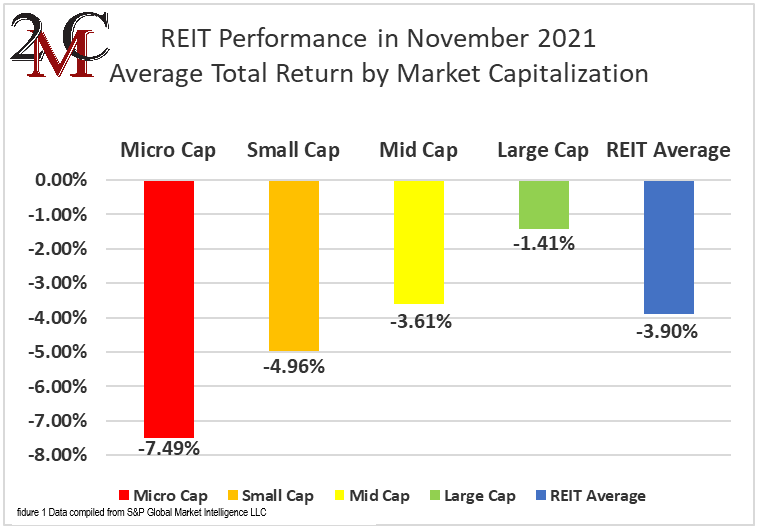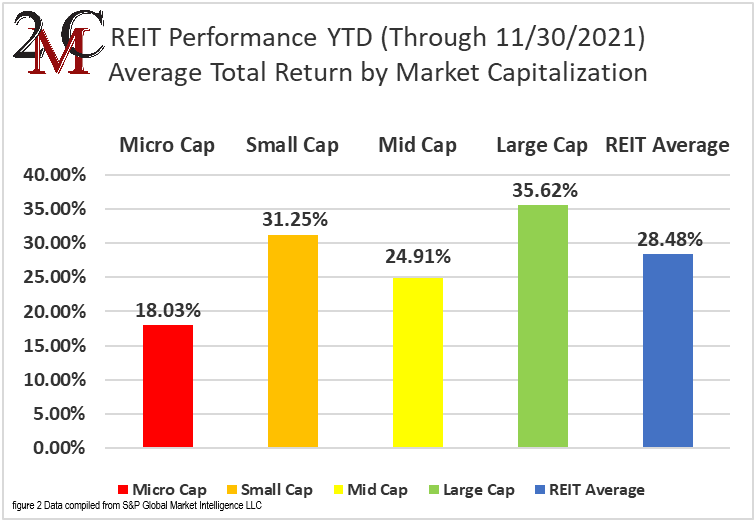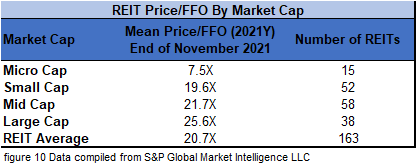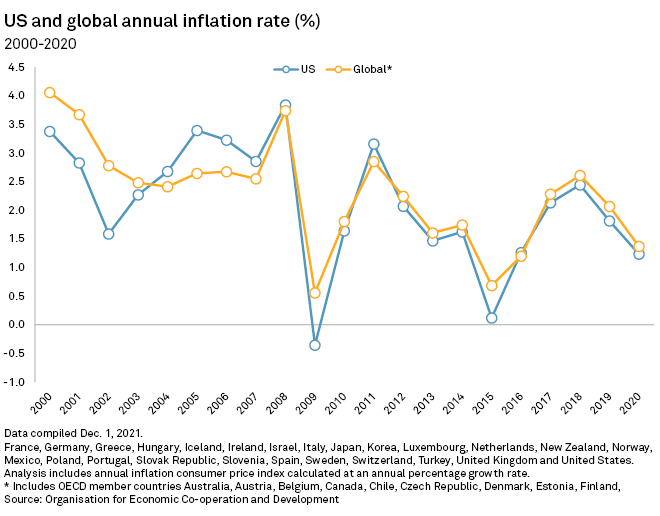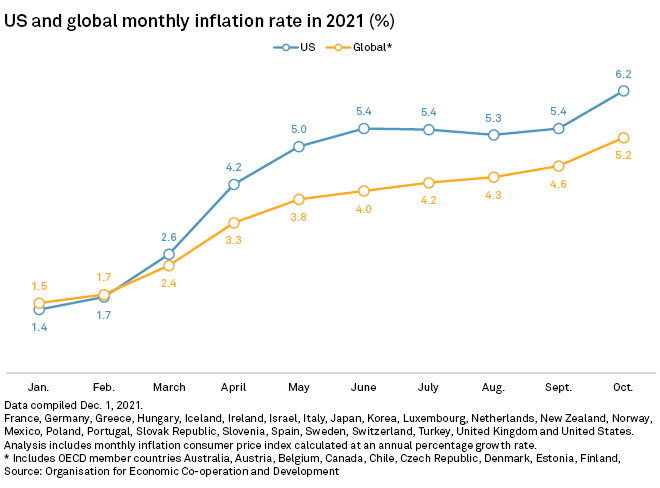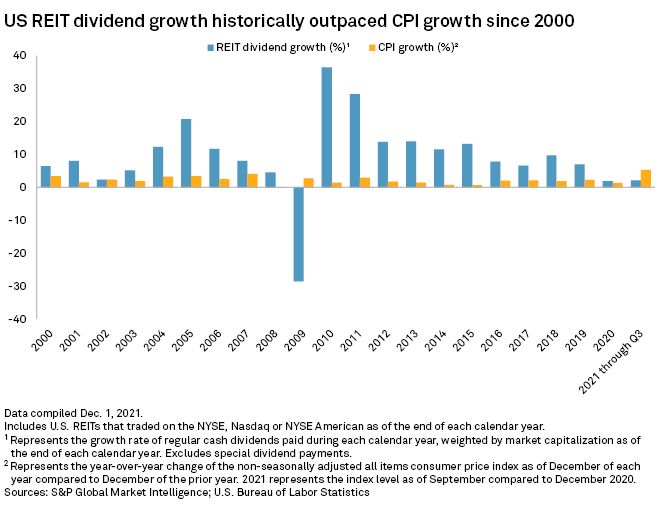The State of REITs: December 2021 Edition
- REITs have only had negative total returns in 2 of the first 11 months of 2021, including November’s -3.90% average return.
- Large cap (-1.41%) and Mid cap REITs (-3.61%) outperformed with only modest share price declines, while microcaps (-7.49%) suffered heavier losses.
- Only 29.55% of REIT securities had a positive total return in November.
- Land (+7.21%) and Data Centers (+5.29%) outperformed all REIT property types in November. Hotel (-12.34%) and Casino (-8.51%) REITs suffered the steepest declines.
- The average REIT NAV discount widened to -6.98% in November. The median NAV premium at the end of October flipped to a discount of -4.44% by the close of November.
REIT Performance
After starting the year with 8 straight months of gains, the REIT sector has now fallen in two of the past three with a -3.90% total return in November. The broader market had a better performance in November, as the NASDAQ (+0.25%) and S&P 500 (-0.83%) handily outperformed the REIT sector while the Dow Jones Industrial Average (-3.73%) also narrowly outpaced REITs. The market cap weighted Vanguard Real Estate ETF (VNQ) outperformed the average REIT in November (-2.11% vs. -3.90%) and has nearly caught up to the YTD performance of the average REIT (+28.11% vs. +28.48%). The spread between the 2021 FFO multiples of large cap REITs (25.6x) and small cap REITs (19.6x) narrowed slightly in November as multiples decreased by 0.3 turns for large caps and by only 0.2 turns for small caps. In this monthly publication, I will provide REIT data on numerous metrics to help readers identify which property types and individual securities currently offer the best opportunities to achieve their investment goals.
6 out of 20 Property Types Yielded Positive Total Returns in November
30% of REIT property types averaged a positive total return in November, with a wide 19.55% total return spread between the best and worst performing property types. Hotel (-12.34%) and Casino (-8.51%) REITs had the worst average total return in November. Hotels sold off largely due to uncertainty regarding the impact on travel of the new Omicron variant of the coronavirus, both in terms of potentially reduced travel interest and the risk of an unfavorable government response. The two hardest hit Hotel REITs in November were Ashford Hospitality Trust (AHT) and Innsuites Hospitality Trust (IHT) with -27.80% and -21.67% declines respectively.
Land (+7.21%) and Data Center (+5.29%) REITs led all property types in November. Data Centers were led by CoreSite Realty (COR) and CyrusOne (CONE) with +16.01% and +7.21% gains respectively. Both REITs announced on November 15th that they had reached agreements to be acquired, with KKR and Global Infrastructure Partners (GIP) purchasing CyrusOne while American Tower (AMT) is purchasing CoreSite.
Performance of Individual Securities
The acquisition of VEREIT (VER) by Realty Income (O) was completed on November 1st as the merged entity continued to trade under the O ticker symbol. VEREIT shareholders received 0.705 shares of O for each share of VER held. Realty Income then spun off all of the office properties of the combined entity into a new publicly traded REIT, Orion Office REIT (ONL).
Pennsylvania REIT (PEI) saw the biggest losses of any REIT in November (-29.41%) but remains up 20% YTD. The share price decline in November was driven by the release of another quarter of poor earnings as FFO/share and AFFO/share remain negative and occupancy remains below 92%.
Gladstone Land (LAND) was the best performing REIT in November with an +24.47% total return. LAND continues to be awarded higher and higher multiples (now up to 43.37X) as investors have sought safety in the stable farmland asset class and strong management team at Gladstone. This gain was also fueled by a solid Q3 earnings beat posted on November 9th.
29.55% of REITs had a positive return in November with 80.22% in the black year to date. During the first eleven months of last year, the average REIT had a disappointing -14.68% return, whereas this year the average REIT has seen an excellent total return of +28.48%.

Dividend Yield
Dividend yield is an important component of a REIT’s total return. The particularly high dividend yields of the REIT sector are, for many investors, the primary reason for investment in this sector. As many REITs are currently trading at share prices well below their NAV, yields are currently quite high for many REITs within the sector. Although a particularly high yield for a REIT may sometimes reflect a disproportionately high risk, there exist opportunities in some cases to capitalize on dividend yields that are sufficiently attractive to justify the underlying risks of the investment. I have included below a table ranking equity REITs from highest dividend yield (as of 11/30/2021) to lowest dividend yield.

Although a REIT’s decision regarding whether to pay a quarterly dividend or a monthly dividend does not reflect on the quality of the company’s fundamentals or operations, a monthly dividend allows for a smoother cash flow to the investor. Below is a list of equity REITs that pay monthly dividends ranked from highest yield to lowest yield.
REIT Premium/Discount to NAV by Property Type
Below is a downloadable data table, which ranks REITs within each property type from the largest discount to the largest premium to NAV. The consensus NAV used for this table is the average of analyst NAV estimates for each REIT. Both the NAV and the share price will change over time, so I will continue to include this table in upcoming issues of The State of REITs with updated consensus NAV estimates for each REIT for which such an estimate is available.
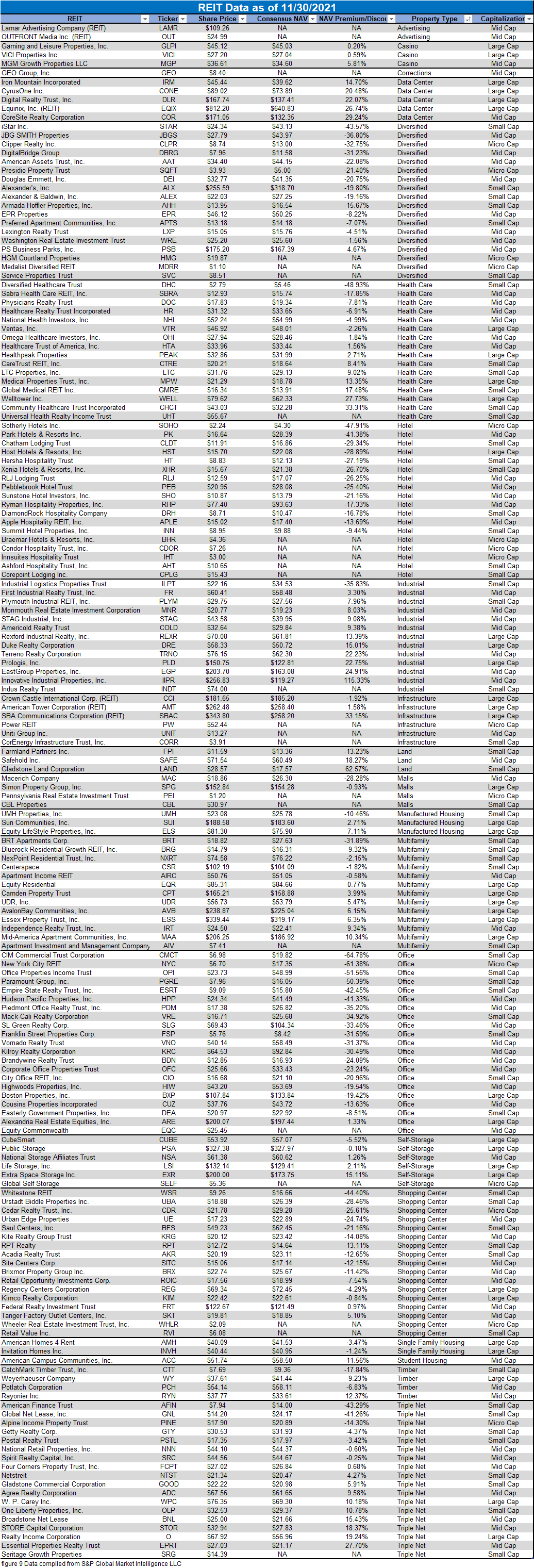
Takeaway
The large cap REIT premium (relative to small cap REITs) significantly increased during 2019 and further expanded during 2020. However, it has significantly narrowed during 2021. Investors are now paying on average about 31% more for each dollar of 2021 FFO/share to buy large cap REITs than small cap REITs (25.6x/19.6x – 1 = 30.6%). As can be seen in the table below, there is presently a strong positive correlation between market cap and FFO multiple.
The table below shows the average premium/discount of REITs of each market cap bucket. This data, much like the data for price/FFO, shows a strong, positive correlation between market cap and Price/NAV. The average large cap REIT (+5.82%) trades at a single-digit premium to consensus NAV and mid cap REITs (-5.46%) on average trade at a single-digit discount. Small cap REITs (-15.43%) trade at a double-digit discount, whereas micro caps on average trade at less than 2/3 of their respective NAVs (-38.31%).
Inflation is always a factor worth considering when making investment decisions, but it has become increasingly important throughout the year as massive government stimulus and global supply chain disruptions have sent inflation rates sky-high. The Federal Reserve’s forecast of merely “transitory” inflation hasn’t panned out and each month we are now seeing fresh highs in the inflation rate. Although inflation is a growing problem in nations around the world, it is hitting the US even harder.
From 2017 to 2020 US inflation was lower than the global average. However, since March 2021 US inflation has outpaced the global average, soaring to 6.8% in November. This is the highest inflation rate since 1982 and without swift action from the Fed could potentially rise much higher.
Inflation of this magnitude is going to impact the cost of all aspects of life. Investors would be wise to carefully examine where they are investing their money to ensure they are getting enough of a return to offset these elevated costs. Treasuries that are not inflation-indexed, for example, provide a yield far below that of inflation without price appreciation potential large enough to offset that shortfall. This results in a total return that is very likely to fall short of the inflation rate, resulting in a loss of purchasing power for the treasury investor. Investment in appreciating assets with growing dividend streams, however, has the potential to produce a total return in excess of the inflation rate.
REIT dividend growth has been robust over the past 2 decades and has consistently outpaced the rate of inflation. This is one of the reasons that REITs have often been able to outperform the broader market. Although inflation is likely to outpace dividend growth over upcoming quarters (as it has thus far in 2021), REITs still represent a better inflation hedge than most other asset classes. REITs have the potential to capitalize on the inflation and significantly outperform because they are able to raise rents and benefit from rising property values.
Important Notes and Disclosure
All articles are published and provided as an information source for investors capable of making their own investment decisions. None of the information offered should be construed to be advice or a recommendation that any particular security, portfolio of securities, transaction, or investment strategy is suitable for any specific person. The information offered is impersonal and not tailored to the investment needs of any specific person.
We cannot determine whether the content of any article or recommendation is appropriate for any specific person. Readers should contact their financial professional to discuss the suitability of any of the strategies or holdings before implementation in their portfolio. Research and information are provided for informational purposes only and are not intended for trading purposes. NEVER make an investment decision based solely on the information provided in our articles.
We may hold, purchase, or sell positions in securities mentioned in our articles and will not disclose this information to subscribers, nor the time the positions in the securities were acquired. We may liquidate shares in profiled companies at any time without notice. We may also take positions inconsistent with the information and views expressed on our website.
We routinely own and trade the same securities purchased or sold for advisory clients of 2MCAC. This circumstance is communicated to our clients on an ongoing basis. As fiduciaries, we prioritize our clients’ interests above those of our corporate and personal accounts to avoid conflict and adverse selection in trading these commonly held interests.
Past performance does not guarantee future results. Investing in publicly held securities is speculative and involves risk, including the possible loss of principal. Historical returns should not be used as the primary basis for investment decisions. Although the statements of fact and data in this report have been obtained from sources believed to be reliable, 2MCAC does not guarantee their accuracy and assumes no liability or responsibility for any omissions/errors
Commentary may contain forward-looking statements that are by definition uncertain. Actual results may differ materially from our forecasts or estimations, and 2MCAC and its affiliates cannot be held liable for the use of and reliance upon the opinions, estimates, forecasts, and findings in this article.
Through October 2021, The State of REITs was published exclusively on Seeking Alpha by Simon Bowler, Sector Analyst at 2nd Market Capital Services Corporation (2MCSC). Editions subsequent to October 2021 will be published on this website in addition to other platforms that may include Seeking Alpha. 2MCSC was formed in 1989 and provides investment research and consulting services to the financial services industry and the financial media. 2MCSC does not provide investment advice. 2MCSC is a separate entity but related under common ownership to 2nd Market Capital Advisory (2MCAC), a Wisconsin registered investment advisor. Simon Bowler is an investment advisor representative of 2MCAC. Any positive comments made by others should not be construed as an endorsement of the author's abilities to act as an investment advisor.
S&P disclosure: S&P Global Market Intelligence LLC. Contains copyrighted material distributed under license from S&P.

